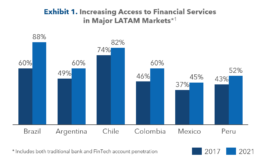Credit Cards are Fading...
The payments industry has been experiencing explosive growth across Latin America over the past few years: cash usage has decreased ~20% as consumers pivoted towards payment products that are well integrated into the financial ecosystem. Although total retail spending decreased 18% during the first year of the pandemic, P2P transfers and real-time payments have seen high levels of adoption. In fact, digital banks and wallets have reached more than 50% of the banked population and 33% of the overall population (1).
However, this growth in payments did not translate to growth for credit cards. Credit cards have only grown 1-3% in the recent years. While credit cards accounted for ~60% of all LatAm card purchases in 2019, it has decreased to ~35% due to the increasing popularity of debit and prepaid cards (2).
There are multiple reasons for this struggle:
Competition from FinTechs. Technological payment options such as P2P payments, advanced security features and digital payment cards have gained traction due to the growing mobile penetration (70%)(3). Especially real-time payments have been cannibalizing credit cards as they are free of charge to the customers and help merchants bypass interchange fees.
Barriers to Customer Uptake. Costs of obtaining a card and associated red tape have also damaged the popularity of credit cards in the region. In Brazil, new card adoption has been low because, on average, consumers pay 190% annual interest on credit cards. Moreover, less than 50% of Latin Americans have a credit score history to begin with, and credit bureaus of countries like Chile only register negative strikes against credit, further lowering card approval rates(4).
Regulatory Challenges. Many Latin American governments have laws in place that restrict credit card growth. The Central Bank of Argentina has fixed APRs at 55%, which has been deterring issuers from promoting their credit cards due to limited opportunity for interest revenue (5).
Governments in Brazil, Colombia and Puerto Rico issue their social benefit payments through prepaid cards distributed by public banks. While this is good for lowering cash usage and increasing financial participation, prepaid and debit cards pose a threat to credit cards by capturing first-time customers.
Exhibit 1. Increasing Access to Financial Services in Major LATAM Markets*
...But their value continues
The challenges above might be discouraging for issuers, but credit cards are still one of the most important products within their portfolios. Credit cards are big contributors to customer loyalty and holistic growth:
Higher Revenue. Credit cards typically contribute higher revenue compared to other payment products because of their multiple revenue streams. Cardholders pay annual fees and interest on unpaid balances , while merchants are charged interchange fees, allowing issuers to monetize their credit cards with each purchase. Research shows that customers spend up to 100% more when they use credit cards and are more likely to accept higher prices (6).
Access to Insightful Consumer Data. Big data analytics have become integral to the payment industry and credit cards give issuers access to insightful data (e.g., purchase frequency, spending categories, customer service preferences etc.). These data points allow issuers to drive growth across their entire product portfolio by segmenting customers, personalizing product offerings, implementing risk management processes, and incorporating retention strategies.
Long-Lasting Client Relationships. Despite a sharp drop credit card satisfaction during the C-19 pandemic, 89% of cardholders indicated that they would remain loyal to their issuers. This is because credit cards are interconnected with entire ecosystems of financial products (e.g., higher tier cards, investment products and fixed-term loans), resulting in longer-term and more intertwined issuer-client engagement (7).
Using Rewards to Catalyze Growth
LatAm’s dynamic and competitive landscape calls for innovative credit card value propositions. Issuers have a powerful tool at their disposal to accomplish this: reward schemes. ~80% of customers consider rewards as a differentiator in choosing a card, however, credit card reward satisfaction rates are at ~50%: once revolutionary and eye-catching reward schemes such as the single-rate universal cashback and point programs are no longer considered interesting. Issuers now need to offer newer, more attractive value propositions (8).
There are multiple whitespace opportunities for such rewards in Latin America. Issuers have focused their card strategy towards high- and middle-income segments and mainly offered travel rewards. However, the C-19 pandemic has rendered travel rewards difficult to redeem and issuers have been slow to adjust their reward strategies. On the flipside, issuers have struggled with lowering their cost to acquire low and lower-middle income segments. Instead, so far these segments have been served by prepaid and debit cards, which have a significantly lower ability to drive growth due to their restrictive revenue models.
Rewards present an opportunity for credit card issuers to offer value propositions tailored for the nuanced needs of customer segments, markets, and competitor strategies.
1. Dynamic Rewards
Latin American issuers already deploy some dynamic strategies for credit cards: many FinTechs offer dynamic CVV numbers for actively changing security credentials, and traditional banks proactively increase credit lines to stimulate additional spending. It is now time for reward schemes to evolve in order to respond to varying spending patterns and keep their cardholders engaged.
Conditional One-Time Offers
One-time offers that reward task completion are a way to gamify the cardholder experience.
Issuers can offer higher earn rates, special bonuses, and discounts to customers for meeting certain spending minimums to aid in customer activation. For example, in Brazil, where card members prefer to give clothes and shoes as Christmas gifts, spending at select department stores can be rewarded during this period. However, Colombians generally prefer to buy their holiday gifts early so a similar strategy can be offered in November instead (9).
Accelerated Rewards for Revolving Categories
Reward schemes can be made more dynamic by offering higher rewards for select spending categories on a revolving basis. For example, BNPL schemes for larger purchases like travel bookings, are quite popular. Since these schemes are usually set-up directly with merchants as a direct withdrawal or cash payment, they don’t incur interchange fees. Thus, there is an opportunity for issuers to adjust their revolving reward categories seasonally to transfer high-ticket purchases like travel bookings to credit cards.
2. Flexible Rewards
~70% of credit card customers modify when/where they purchase to maximize their rewards, and issuers need to integrate flexibility in their reward schemes to meet customer expectations (10). Flexible strategies not only give customers freedom to adjust how they earn rewards, but also provide issuers with a tool to readjust their value proposition when market conditions change.
Accelerated Rewards for Preferred Categories
One of the most popular reward schemes is to allow customers to choose the category they would like to earn accelerated rewards in and update this category periodically. However, because this scheme is commonplace in crowded markets, issuers need to offer additional flexibility to differentiate themselves. While most cards allow for the selection of one category monthly, an enhanced accelerated reward strategy could let customers select 2-3 categories monthly or quarterly. More flexibility would motivate customers to use a single card for all of their purchases, resulting in more active card usage.
Flexible Reward Redemption Options
Travel co-branded cards have struggled during the pandemic because earning miles no longer held real value at a time with extensive restrictions and low demand for travel. Similarly, cards issuing cashback did not perform well in markets where the pandemic eroded people’s incomes and getting direct discounts became more important to the cost-conscious customers. By giving customers a variety of redemption options such as cash, points and discounts, issuers can meet the changing needs of their customers and respond to market shocks easily. Moreover, issuers can target a greater range of customer segments with a single product through the versatility of the multiple redemption options.
Exhibit 2. Spectrum of Reward Flexibility
3. Hyper-personalized Rewards
While there has been plenty of innovation in the payment space, credit card reward schemes have mainly stayed the same in many Latin American nations. Most credit card rewards still follow a one-size-fits-all approach (e.g., single-rate reward earning schemes), resulting in generic value propositions that fail to attract customer interest.
Research shows that customers are 8x more likely to remain loyal to their credit card if the loyalty program is personalized to their needs and expectations. However, only 22% of credit card customers are satisfied with the level of personalization they are getting today (11). Issuers can employ hyper-personalized reward schemes that put the customer first to gain a competitive edge.
Automatic Accelerated Reward Category Selection
Cardholders whose loyalty program makes them feel special and recognized have a 2.7x higher satisfaction rates. Issuers can automatically adjust their customers’ top earning category to offer a tailored reward experience (12).
This strategy offers a personalized alternative to rewards with manual category selection as customers would be assured that their rewards follow their spending patterns and deliver maximum benefits.
Targeted Offers at Select Merchants
Discounts on select merchants is a common reward scheme in markets such as Argentina and Uruguay, and issuers can differentiate themselves by offering spend-driven personalized discounts.
This strategy is especially impactful for lower-income customer segments who are seeking to keep their costs low. Targeted and personalized discounts present the card as an ever-evolving product that prioritizes the customers’ needs.
4. Alternative Rewards
There is still significant white space in Latin America for differentiated credit cards. Dynamic, flexible, and hyper-personalized rewards can be further enhanced by targeting particular customer segments and offering unique value propositions in crowded yet static environments.
Double Rewards
Double reward refers to issuing rewards in two installments: the first half when the customer makes purchases and the second half when they pay off their balance in full. This is a low-risk strategy for issuers to market credit-builder products to first time cardholders.
Double reward is also suitable for markets where there is a shortage of credit reporting agencies and bureaus such as the Bahamas. Promoting healthy credit behavior can help issuers build internal credit reports that can later be used to upgrade customers to higher card tiers.
Reward Match
Issuers can match the rewards earned by a cardholder at their account anniversary as a bonus. Reward matching is especially suitable for mature card markets with high attrition rates and intense competition, such as Brazil where cardholders have on average 3.6 credit cards (13). Customers in these markets often switch between cards to maximize rewards, and reward matching can build customer stickiness due to the year-long waiting period. For cards with annual fees, the delay in redemption also locks in fees for another year, partially offsetting the cost of the reward match.
Cryptocurrency Rewards
Latin American countries have been adopting cryptocurrencies at a record rate: El Salvador has declared Bitcoin as its legal tender and companies across the region offer crypto-backed loans with APRs as low as 2%. Issuers can take advantage of this recent trend by offering cashback in popular digital currencies (e.g., Ethereum and Bitcoin) or depositing rewards into a trading platform to be converted into the customer’ preferred cryptocurrency (14).
These rewards are suitable for markets with high economic uncertainty and a lack of trust in the local currency. Due to hyperinflation in countries like Venezuela and Argentina, cryptocurrencies are already being used by citizens to hedge their incomes against spiking consumer prices (15). Crypto rewards in these markets would turn rewards into a form of investment and drive spending even during economic crises. Such rewards are also especially appealing to a younger and more tech-savvy customer base.
Minimizing Issuer Liability
One of the most important aspects of establishing a reward strategy is ensuring that the issuer is protected against high acquisition and ongoing costs of rewards. An average issuer’s reward expenses have shown a ~30% increase in the recent years, reinforcing the importance of protecting the bottom line while offering rewards (16). Issuers can employ the following strategies to turn credit card rewards into a sustainable growth tool:
Require Minimum Accrual for Redemption
Minimum accrual requirements create target spending thresholds and can promote card use for several months for thin file customers. Such requirements ensure that customers enticed by welcome offers actively continue using their cards.
Flexible Reward Redemption Options
This strategy encourages cardholders to continue making purchases on their card and remain active throughout the statement month. Allowing access to rewards like cashback after the closing date often prompts cardholders to use these rewards to lower their card debt, keeping the monetary value of rewards within the issuer’s card ecosystem.
Incentivize Internal Reward Redemption
Reward multipliers can be offered on internal redemption portals such as travel booking and gift card purchases. This reduces the real cost of rewards as issuers usually lock in discounted rates through their partnerships with service providers and keep a larger share of interchange fees.
Establish Caps on Rewards
Imposing earning caps is especially popular with cards that offer highly accelerated rates for select categories. As customers can selectively use different credit cards to maximize their rewards, caps ensure holistic card use for all purchase categories.
In Closing...
The LatAm payments industry is growth exponentially, and credit card issuers must proactively enhance their value proposition to remain competitive and capture their share of this growth. There are still several whitespace opportunities for credit cards across the region, and issuers can use reward schemes to their advantage.
Dynamic, flexible, hyper-personalized and alternative reward schemes have a great potential to help issuers with customer loyalty and activation, driving long-term growth. However, reward schemes cannot follow a one-size-fits-all approach. Credit card markets across the region vary greatly and reward strategies need to be tailored to competitive landscapes, regulatory frameworks, macroeconomic conditions, and attributes of targeted segments.
Issuers also need to have a holistic approach to connecting with their customers and going beyond product-focused strategies. The dynamisms of the payments landscape in LatAm requires issuers to pair cards with additional offerings such as digital wallet integration and advanced security features, offering holistically innovative credit card value propositions.
__________________________________________________________________________________________________________
- LATAM Payments Megatrends Report, Americas Market Intelligence, 2021
- Acceleration in LATAM Digital Payments, PYMNTS, 2021
- Mobile Penetration in LATAM, Geopoll, 2021
- LATAM Lending Landscape, Lending Times, 2018
- Financial Cards and Payments in Argentina, Euromonitor International, 2021
- Do People Really Spend More With Credit Cards, Forbes, 2018
- Credit Card Satisfaction Study, JD Power, 2021
- Majority Say Credit Card Rewards Are Very Important and Drive Card Usage, Ipsos, 2021
- Christmas in Latin America, Statista, 2015
- What’s Trending in Loyalty?, Bond Brand Loyalty, 2016
- What’s Trending in Loyalty?, Bond Brand Loyalty, 2016
- What’s Trending in Loyalty?, Bond Brand Loyalty, 2016
- Brazil Country Report, Verisk Financial, 2021
- Bitcoin Adoption in Latin America, Nasdaq, 2021
- Inflation Seen Spiking Festive Spending Splurge, Reuters, 2022
- Consumer Payment Survey, Deloitte, 2020

















































